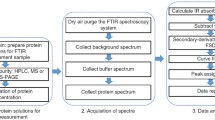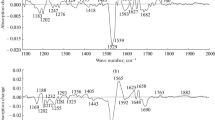Abstract
Mid-infrared spectroscopy is one of the major analytical techniques employed for measurements of protein structure in solution. Traditional Fourier Transform-Infrared (FT-IR) measurement is limited by its blackbody light source that is inherently spatially incoherent and has low optical power output. This limitation is pronounced when working with proteins in aqueous solutions. Strong absorbance of water in protein amide I region 1600–1700 cm−1 restricts light path length to <10 μm and imposes significant experimental challenges in sample and flow cell handling. Emerging laser spectroscopic techniques use high-power coherent laser as light source that overcomes the limitation in FT-IR measurement. In this study, we employed an innovative infrared spectrometer that uses quantum cascade laser (QCL) as light source. Continuous infrared radiation from this laser source can be swiftly swept within the amide I region (1600–1700 cm−1) and amide II region (1500–1600 cm−1), which makes this technique ideal for protein secondary structure study. Protein solutions as low as 0.5 mg/mL were measured rapidly without any sample preparation. Infrared spectra of model proteins were thus collected, and a chemometric model based on partial least squares regression was developed to quantify α-helix and β-strand motifs in protein secondary structure. The model was applied to measurement of the native secondary structure of commercial therapeutic proteins and bovine serum albumin (BSA) and in thermal degradation studies.











Similar content being viewed by others
References
Baker M. Structural biology: the gatekeepers revealed. Nature. 2010;10:823–6.
Moraes I, Quigley A. Structural biology and structure-function relationships of membrane proteins. Biology. 2021;10(3):245.
Rost B. Review: protein secondary structure prediction continues to rise. J Struct Biol. 2001;134:204–18.
Xie M, Schowen RL. Secondary structure and protein deamidation. J Pharm Sci. 1999;88:8–13.
Pelton JT, McLean LR. Spectroscopic methods for analysis of protein secondary structure. Anal Biochem. 2000;277:167–76.
Bose K, Rathore I, Mishra V, Bhaumik P. Advancements in macromolecular crystallography: from past to present. Emerg Top Life Sci. 2021;5:127–49.
Kay LE. NMR studies of protein structure and dynamics. J Magn Reason. 2005;173:193–207.
Miles AJ, Janes RW, Wallace BA. Tools and methods for circular dichroism spectroscopy of proteins: a tutorial review. Chem Soc Rev. 2021;50:8400–13.
Sergei K. CD spectroscopy has intrinsic limitations for protein secondary structure analysis. Anal Biochem. 2009;389:174–6.
Elliott A, Ambrose EJ. Structure of synthetic polypeptides. Nature. 1950;165:921–2.
Yang H, Yang S, Kong J, Dong A, Yu S. Obtaining information about protein secondary structures in aqueous solution using Fourier transform IR spectroscopy. Nat Protoc. 2015;3:382–96.
López-Lorente ÁI, Mizaikoff B. Mid-infrared spectroscopy for protein analysis: potential and challenges. Anal Bioanal Chem. 2016;408:2875–89.
Krimm S, Bandekar J. Vibrational spectroscopy and conformation of peptides, polypeptides, and proteins. Adv Protein Chem. 1986;38:181–364.
Barth A. Infrared spectroscopy of proteins. Biochim Biophys Acta. 1767;2007:1073–101.
Lee J, Kang TD, Chae B. Synchrotron infrared spectroscopy. J Phys High Tech. 2012;21:30.
Maragkou M. Supercontinuum: reaching the mid-infrared. Nat Photonics. 2014;8:746.
Yu Y, Anthony JH, Claire FG. Mid-infrared quantum cascade lasers. Nat Photonics. 2012;6:432–9.
Faist J, Capasso F, Sivco DL, Sirtori C, Hutchinson AL, Cho AY. Quantum cascade laser. Science. 1994;264:553–6.
Kuligowski S, Alcaráz Q, Lendl B. External cavity-quantum cascade laser (EC-QCL) spectroscopy for protein analysis in bovine milk. Anal Chim Acta. 2017;963:99–105.
Alcaráz MR, Schwaighofer A, Goicoechea H, Lendl B. EC-QCL mid-IR transmission spectroscopy for monitoring dynamic changes of protein secondary structure in aqueous solution on the example of β-aggregation in alcohol-denaturated α-chymotrypsin. Anal Bioanal Chem. 2016;408:3933–41.
Schwaighofer A, Alcaraz MR, Lux L, Lendl B. pH titration of β-lactoglobulin monitored by laser-based mid-IR transmission spectroscopy coupled to chemometric analysis. Spectrochim Acta A Mol Biomol Spectrosc. 2020;226:117636.
Ivancic VA, Lombardo HL, Ma E, Wikström M, Batabyal D. Advancing secondary structure characterization of monoclonal antibodies using microfluidic modulation spectroscopy. Anal Biochem. 2022;646:114629.
Liu LL, Wang L, Zonderman J, Rouse JC, Kim HY. Automated, high-throughput infrared spectroscopy for secondary structure analysis of protein biopharmaceuticals. J Pharm Sci. 2020;109:3223–30.
Dong A, Huang P, Caughey WS. Protein secondary structures in water from second-derivative amide I infrared spectra. Biochemistry. 1990;29:3303–8.
Susi H, Byler M. Fourier deconvolution of the amide I Raman band of proteins as related to conformation. Appl Spectrosc. 1988;42:819–26.
Cai S, Singh BR. A distinct utility of the amide III infrared band for secondary structure estimation of aqueous protein solutions using partial least squares methods. Biochemistry. 2004;43:2541–9.
Wilcox KE, Blanch EW, Doig AJ. Determination of protein secondary structure from infrared spectra using partial least-squares regression. Biochemistry. 2016;55:3794–802.
Takeda K, Wada A, Yamamoto K, Moriyama Y, Aoki K. Conformational change of bovine serum albumin by heat treatment. J Protein Chem. 1989;8:653–9.
Hawe A, Wiggenhorn M, van de Weert M, Garbe JH, Mahler HC, Jiskoot W. Forced degradation of therapeutic proteins. J Pharm Sci. 2012;101:895–913.
Mickey CD. Chemical kinetics: reaction rates. J Chem Ed. 1980;57:659.
Borzova VA, Markossian KA, Chebotareva NA, Kleymenov SY, Poliansky NB, Muranov KO, Stein-Margolina VA, Shubin VV, Markov DI, Kurganov BI. Kinetics of thermal denaturation and aggregation of bovine serum albumin. PLoS ONE. 2016;11:e0153495.
Vermeer AW, Norde W. The thermal stability of immunoglobulin: unfolding and aggregation of a multi-domain protein. Biophys J. 2000;78:394–404.
Akazawa-Ogawa Y, Nagai H, Hagihara Y. Heat denaturation of the antibody, a multi-domain protein. Biophys Rev. 2018;10:255–8.
Indyk HE, Williams JW, Patel HA. Analysis of denaturation of bovine IgG by heat and high pressure using an optical biosensor. Int Dairy J. 2008;18:359–66.
Akazawa-Ogawa Y, Takashima M, Lee YH, Ikegami T, Goto Y, Uegaki K, Hagihara Y. Heat-induced irreversible denaturation of the camelid single domain VHH antibody is governed by chemical modifications. J Biol Chem. 2014;289:15666–79.
Funding
This work is the result of research projects funded by Bristol-Myers Squibb Company.
Author information
Authors and Affiliations
Contributions
The manuscript was written through contributions of all authors. All authors have given approval to the final version of the manuscript.
Corresponding authors
Ethics declarations
Conflict of Interest
The authors declare that they have no known competing financial interests or personal relationships that could have appeared to influence the work reported in this paper.
Additional information
Publisher’s Note
Springer Nature remains neutral with regard to jurisdictional claims in published maps and institutional affiliations.
Supplementary Information
ESM 1
(DOCX 42 kb)
Rights and permissions
Springer Nature or its licensor (e.g. a society or other partner) holds exclusive rights to this article under a publishing agreement with the author(s) or other rightsholder(s); author self-archiving of the accepted manuscript version of this article is solely governed by the terms of such publishing agreement and applicable law.
About this article
Cite this article
Jin, C., Patel, A., Peters, J. et al. Quantum Cascade Laser Based Infrared Spectroscopy: A New Paradigm for Protein Secondary Structure Measurement. Pharm Res 40, 1507–1517 (2023). https://doi.org/10.1007/s11095-022-03422-8
Received:
Accepted:
Published:
Issue Date:
DOI: https://doi.org/10.1007/s11095-022-03422-8




